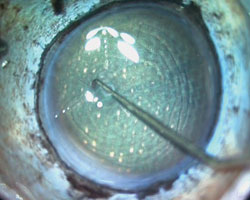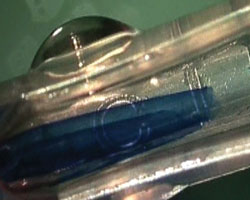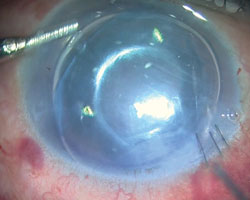DMEK can be combined with phaco in elderly Fuchs' corneal dystrophy patients
The elderly population is often afflicted with comorbid pathology such as cataract with glaucoma or cataract with age-related macular degeneration. Two other conditions that can sometimes coexist are cataract and Fuchs’ corneal dystrophy.
The preferred treatment plan in such patients often varies from surgeon to surgeon and from one patient to another. Early Fuchs’ dystrophy associated with visually insignificant nuclear sclerosis may be left alone with only medical management until the vision is affected secondary to progression of either the cataract or the Fuchs’ dystrophy. Surgery for a cataract that has progressed to a visually disabling level often leads to a worsening of the endothelial disease and consequent need for a keratoplasty. In a patient with significant endothelial disease, a triple procedure with cataract extraction, IOL implantation and keratoplasty is often indicated.
With the recent advances in posterior lamellar keratoplasties in the form of Descemet’s stripping automated endothelial keratoplasty and Descemet’s membrane endothelial keratoplasty, a new small-incision triple procedure is now possible. This essentially consists of phacoemulsification and foldable IOL implantation combined with DSAEK/DMEK. It is indicated for those patients with Fuchs’ dystrophy who have no anterior stromal scarring.
Posterior lamellar keratoplasty techniques
The recent increase in the number of surgeons who prefer to perform DSAEK/DMEK signifies the importance of the advantages that these procedures offer. Gerrit Melles, Francis Price, Mark Terry, Massimo Busin, Mark Gorovoy, Thomas John and Donald Tan, among others, have been at the forefront of research on posterior lamellar keratoplasties, and this field is at a very exciting stage in its development.
DMEK offers the advantage of being able to perform the entire surgery without the need for any special instrumentation other than those routinely available. DMEK can be performed through small incisions, thus offering all the intraoperative advantages of a closed system of surgery. These advantages include safer, more controlled surgery with a greatly decreased risk of complications associated with open sky techniques and larger incisions. The small incision is also associated with a lesser risk of postoperative regular and irregular astigmatism, wound leak, shallow anterior chamber and endophthalmitis.
Surface complications are also decreased because the corneal sensory nerves are not cut, unlike in penetrating keratoplasty. There is also a lesser risk of suture-related complications as well as graft rejection with DMEK as compared with PK. More importantly, chances of graft rejection are decreased with an endothelium-only transplant as compared with full-thickness grafting
Technique
DMEK is associated with a steep learning curve as compared with DSAEK, and it can be challenging to perform. The DMEK graft can be prepared by carefully stripping the Descemet’s membrane from the donor cornea. Care should be taken that the Descemet’s membrane does not tear during preparation, which would lead to the graft being unusable (Figures 1 to 2). Graft preparation can be done by the SCUBA (submerged cornea using backgrounds away) technique under balanced salt solution, which allows the graft to float, resulting in less endothelial cell loss while harvesting. Pre-cut DMEK tissues are also now available, which increases the ease of the procedure to some extent. Unlike in DSAEK, young donor corneas, although higher in cell density, are not preferred. This is because DMEK grafts harvested from younger corneas often roll up into a tight scroll that is sometimes difficult to unfurl in the anterior chamber. Younger grafts are also more difficult to harvest and less adherent than older DMEK grafts. The greater difficulty in ascertaining correct graft orientation as well as the greater manipulation required to unroll the graft can result in a higher incidence of primary graft failure in DMEK. Despite this, when performed well, the final visual acuity is better with DMEK than with DSAEK.
Bubble management is another crucial step in DMEK because the graft has a greater incidence of dislocation than in DSAEK, consequently often requiring a larger bubble. It is also associated with a higher incidence of re-bubbling than DSAEK.
 Figure 1. DMEK graft being prepared. Donor Descemet’s membrane edge being lifted after scoring. |
 Figure 2. Donor Descemet’s membrane being stripped. |
 Figure 3. The DMEK graft is loaded gently into the cartridge of a STAAR ICL injector filled with balanced salt solution. |
 Figure 4. An air bubble apposes against the corneal stroma. The endothelium faces posteriorly toward the IOL. Images: Agarwal A
|
When combining DMEK with phaco, careful phacoemulsification is carried out after removing the epithelium for better visualization. Maximum care should be taken to avoid any complications, such as a posterior capsular tear or iris sphincter damage, during phaco. Intracameral pilocarpine may be instilled to constrict the pupil if required. The host Descemet’s membrane is scored and stripped using a reverse Sinskey hook, just as in DSAEK. The donor graft is loaded into a STAAR ICL injector, making sure that it floats in balanced salt solution or viscoelastic (Figure 3). The cartridge is introduced into the clear corneal incision, and the graft is gently injected into the eye, taking care to avoid wound-assisted implantation. The side port may be burped as the graft is being introduced to avoid backflush and extrusion of the graft.
Graft orientation is verified, and a small air bubble is used to unfold the graft by gently tapping the bubble. The eddy currents created by injecting balanced salt solution through a cannula into the anterior chamber may also be used to orient and unfold the graft. Once unfolded, a larger air bubble is used to push the graft up against the stroma (Figure 4). The patient is positioned face up in the postoperative period.
Any interface fluid is removed via pre-placed stab incisions in the cornea. An adequately large air bubble is left in the anterior chamber to allow the graft to adhere well.
Conclusion
DMEK has a longer learning curve than DSAEK, but the advantages that it offers over other posterior lamellar keratoplasty techniques as well as PK make it a preferred technique. Further refinements are required to make the surgery easier, safer and more predictable than it is at present. DMEK can be combined with cataract extraction in patients with coexisting cataract and Fuchs’ dystrophy.
For more information:
- Amar Agarwal, MS, FRCS, FRCOphth, is director of Dr. Agarwal’s Eye Hospital and Eye Research Centre. Prof. Agarwal is the author of several books published by SLACK Incorporated, publisher of Ocular Surgery News, including Phaco Nightmares: Conquering Cataract Catastrophes, Bimanual Phaco: Mastering the Phakonit/MICS Technique, Dry Eye: A Practical Guide to Ocular Surface Disorders and Stem Cell Surgery and Presbyopia: A Surgical Textbook. He can be reached at 19 Cathedral Road, Chennai 600 086, India; email: dragarwal@vsnl.com; website: www.dragarwal.com.
- Disclosure: Dr. Jacob and Prof. Agarwal have no relevant financial disclosures.
